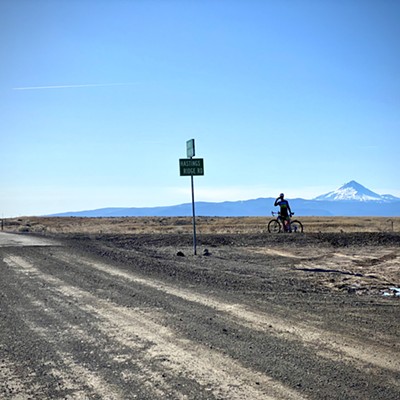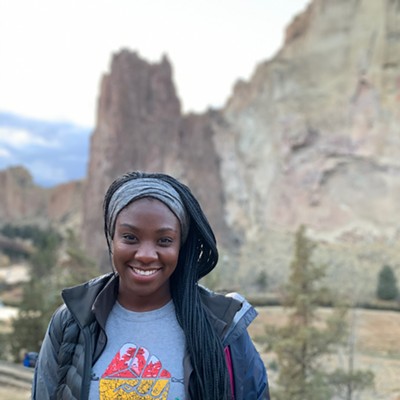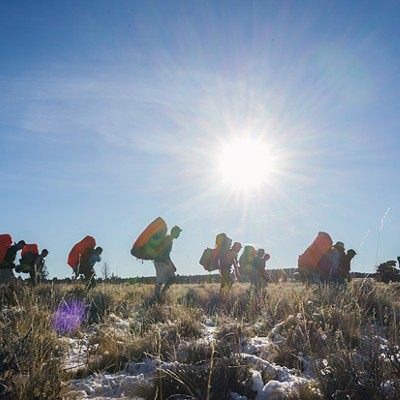Every time I drive over the Ochoco Forest summit I start looking for a moose. The willows along the banks of Marks Creek and quiet switchbacks with the deep forest close by give one the impression of really great moose habitat, and, if that were in the Umatilla or Wallowa-Whitman forest, there would probably be a moose standing in the quiet waters.
There is a small number of moose scattered throughout that part of the state. According to Oregon Department of Fish and Wildlife (ODFW) biologist Pat Matthews, they seem to be doing OK for themselves. However, like all large mammals in the wild, they do have to put up with predators, and as the small population of wolves begins to grow in that area, the moose will have to be quick.
My first encounter with a moose was coming around a curve in Yellowstone National Park; there was a car stopped ahead of me right alongside a moose calf, but what really caught my eye was the huge cow moose with the hair up on her back, chasing a woman who was waving a carrot at it. When one thinks "moose," one sees an image of those big, formidable black males standing on long legs in a sprawling body of water, mosses dripping from huge antlers spread out over the long, horse-like head.
Well, Oregon's moose can be a little like that, but they're smaller in stature. These are Shiras moose, the smallest subspecies in North America. Even so, males still tip the scales at 1,000 pounds —mid-sized when compared with a typical 1,500-pound Alaska-Yukon bull moose. The female Shiras moose can weigh around 700 to 800 pounds. They tend to be dark brown or brownish-black, a color scheme occasionally broken by grayish-white hair on the undersides of their back legs.
Moose are not herd animals, such as deer or elk. They wander around somewhat close together, but separated by a half-mile or so. Last count there were about 60 of them in Oregon, scattered across parts of the Umatilla and Wallowa-Whitman national forests, which is up from 30 in 2006.
Wildlife biologists, such as Matthews, use words like secretive, solitary and elusive to describe the ungainly looking animals, which (probably) migrated into northeastern Oregon from the Spokane-Pullman region, crossing the wide-open Palouse Prairie into Oregon's Blue Mountains.
Moose have been reported from time to time for years in this corner of Oregon, but biologists say the first recorded sighting was along the Imnaha River in 1960, and it's known three moose calves were born in northeastern Oregon in 2005. It's also interesting to note moose numbers began rising about the same time gray wolves started migrating into Oregon from Idaho and reproducing here.
Oregon's Shiras moose population is centered in western Wallowa County, and has also been spotted in the 560-square-mile Eagle Cap Wilderness. On Oregon State Highway 204, drivers may encounter a moose between Elgin and Weston, or on Forest Service Road 62 north of Elgin.
This bit of news comes with a warning. Deer, elk and cows wander across Oregon highways often, and as a result they are sometimes struck and killed. Please keep in mind, Shiras moose— even though smaller than their Yukon cousins — are larger than elk and as such can do considerable damage to a vehicle driving the new Oregon highway speed limit of 65 miles per hour.
Speaking of "limit," there is a limit on the number of deer, elk, black bear, cougar, pronghorn, Rocky Mountain goat, bighorn sheep and Western gray squirrels one can shoot, but there is no hunting season for moose in Oregon.
As if having to put up with wolves and speeding motor vehicles wasn't enough, in 2010 wildlife biologists became aware of a carotid worm parasite problem, which are transmitted to moose by horsefly bites. The parasites travel through the blood vessels to the brain, sometimes triggering poor coordination, blindness and other problems, which is another good reason to drive carefully along the highways in Northeast Oregon.
Now, a request: if you're traveling within or near known moose habitat and spot a moose, and would like to join a growing number of Citizen Scientists, please make a note of your location, stop and take photos if it's safe to do so, then pass along that information to the ODFW office in your area, or the ODFW Enterprise Field Office, Tel. (541)426-3279.
If you see one on the Ochoco summit, call me! Tel.(541)480-3728, but please wait until at least 7:30 a.m.


























